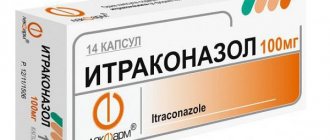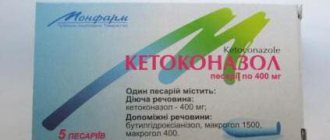Pharmacokinetics
Absorption of itraconazole is greatest when it is taken immediately after a meal. Absorption is variable and depends on the acidity of the environment (best absorption occurs in strongly acidic environments). The active component penetrates well into many tissues and organs; in horny tissues (skin, nails) it reaches a concentration 4 times higher than in plasma. Only in small quantities penetrates into the cerebrospinal fluid. Penetrates through the placenta and into breast milk.
The medication is excreted in urine and feces.
Side effects
Like all medicines, Orungal can cause side effects, although not all people using this medicine get these side effects.
Thus, when taking capsules, gastrointestinal disorders may occur, an increase in liver enzymes, an increase in bilirubin, and jaundice may occur. Very rarely, serious liver damage, hepatitis, acute liver failure, liver damage, and rarely pancreatitis have occurred.
The medicine may cause nervous system disorders such as headache and dizziness, drowsiness, paresthesia (numbness, tingling, sensory disturbances), peripheral neuropathy, visual disturbances (blurred vision, double vision), tinnitus, temporary or permanent hearing loss.
In rare cases, hematological disorders (thrombocytopenia, decreased white blood cell and/or granulocyte count), frequent urination, fever may occur. There may be a decrease in potassium levels and an increase in triglyceride levels in the blood.
Possible hypersensitivity reactions, skin itching, rash, sometimes severe reactions (nettle rash, Quincke's edema, including the face, larynx, glottis, which can make breathing difficult, serum sickness syndrome, severe skin reactions: Stevens and Johnson syndrome, toxic necrosis, erythema multiforme, exfoliative dermatitis, inflammation of small skin vessels).
Description:
Orungal is an antifungal drug produced by the Italian division of Jansen Silag (part of the group). The drug has long been used and recommended by doctors on the Russian market and has proven its unique effectiveness in combating diseases such as:
- cutaneous mycoses
- candidiasis in various places
- histoplasmosis
- blastomycosis
- cryptococcosis
Orungal is also successfully used to prevent the development of fungal infections in patients with serious diseases, in particular, malignant blood pathologies and after bone marrow transplantation.
Drug interactions
Enzyme-inducing agents, such as rifampicin or phenytoin, may significantly reduce the oral bioavailability of itraconazole, requiring monitoring of its plasma concentrations when coadministered with such agents.
Itraconazole may slow the metabolism of pharmaceutical drugs that are metabolized by the cytochrome 3A family, resulting in increased and/or prolonged effects, including side effects. Well-known examples are: terfenadine, astemizole, cisapride, HMG-CoA reductase inhibitors such as lovastatin, oral midazolam and triazolam. These drugs should not be given during treatment with itraconazole.
There is no interaction between Orungal and imipramine, propranolol, diazepam, cimetidine, indomethacin, tolbutamide and sulfamethazine.
Instructions:
Clinical and pharmacological group
09.001 (Antifungal drug)
Release form, composition and packaging
Capsules with an opaque blue cap and a transparent pink body, capsule size No. 0; The contents of the capsules are cream-colored sugar spheres.
| 1 caps. | |
| itraconazole | 100 mg |
Excipients: sucrose, hypromellose, macrogol.
Composition of the capsule shell: titanium dioxide, indigotine, azorubine, gelatin.
4 things. - blisters (1) - cardboard packs. 5 pcs. - blisters (3) - cardboard packs. 6 pcs. - blisters (1) - cardboard packs. 14 pcs. - blisters (1) - cardboard packs. 14 pcs. - blisters (2) - cardboard packs. 14 pcs. - blisters (3) - cardboard packs. 14 pcs. - blisters (6) - cardboard packs.
pharmachologic effect
Antifungal drug, triazole derivative. Itraconazole is active against dermatophytes (Trichophyton, Microsporum, Epidermophyton floccosum); yeast and yeast-like fungi (Candida spp., including Candida albicans, Candida glabrata, Candida krusei, Cryptococcus neoformans, Pityrosporum spp., Trichsporon spp., Geotrichum spp.), Aspergillus spp., Histoplasma spp., Paracoccidioides brasiliensis, Sporothrix schenckii, Fonsecaea spp., Cladosporium spp., Blastomyces dermatitidis, Pseudoallescheria boydii, Penicillium marneffei, as well as other yeasts and molds.
Itraconazole disrupts the synthesis of ergosterol, which is an important component of the cell membrane of fungi, which determines the antifungal effect of the drug.
Pharmacokinetics
Suction
When taken orally, the maximum bioavailability of itraconazole is observed when taking capsules immediately after meals. Cmax in plasma is achieved 3-4 hours after oral administration.
Distribution
With long-term use, Css of itraconazole in plasma is achieved within 1-2 weeks.
Css 3-4 hours after taking the drug is 0.4 mcg/ml (when taking the drug at a dose of 100 mg 1 time/day); 1.1 mcg/ml (when taken at a dose of 200 mg 1 time/day) and 2 mcg/ml (when taken at a dose of 200 mg 2 times/day).
Plasma protein binding is 99.8%.
The concentration of itraconazole in the blood is 60% of the concentration in plasma.
The accumulation of the drug in keratin tissues, especially in the skin, is approximately 4 times higher than the accumulation in plasma, and the rate of its elimination depends on the regeneration of the epidermis.
In contrast to plasma concentrations, which are undetectable 7 days after cessation of therapy, therapeutic skin concentrations persist for 2-4 weeks after cessation of a 4-week course of treatment. Itraconazole is detected in nail keratin as early as 1 week after the start of treatment and persists for at least 6 months after completion of a 3-month course of therapy. Itraconazole is also detected in sebum and, to a lesser extent, in sweat.
Itraconazole is well distributed in tissues that are susceptible to fungal infections. Concentrations in the lungs, kidneys, liver, bones, stomach, spleen and muscles were 2-3 times higher than the corresponding plasma concentrations. Therapeutic concentrations in vaginal tissues remain for another 2 days after the end of a 3-day course of treatment at a dose of 200 mg/day, and 3 days after the end of a one-day course of treatment at a dose of 200 mg 2 times/day.
Metabolism
Itraconazole is metabolized in the liver to form a large number of metabolites, one of which, hydroxy-itraconazole, has an antifungal effect comparable to itraconazole in vitro. Antifungal concentrations of the drug determined by microbiological methods were approximately 3 times higher than those measured by HPLC.
Removal
Elimination from plasma is biphasic, with a final T1/2 of 24-36 hours. Approximately 35% of the dose is excreted in the urine in the form of metabolites within 1 week; Less than 0.03% is excreted unchanged in the urine. About 3-18% of the dose is excreted in feces.
Pharmacokinetics in special clinical situations
In patients with renal failure and in patients with liver cirrhosis, T1/2 of itraconazole and its plasma concentration are slightly increased.
The oral bioavailability of itraconazole may be reduced in some immunocompromised patients, such as neutropenic patients, patients with AIDS, or patients undergoing organ transplantation.
Dosage
Capsules should be taken immediately after meals, swallowed whole.
Recommended doses of Orungal depending on indications are presented in Table 1.
| Indication | Dose | Duration |
| Vulvovaginal candidiasis | 200 mg 2 times/day | 1 day |
| 200 mg 1 time/day | 3 days | |
| Pityriasis versicolor | 200 mg 1 time/day | 7 days |
| Dermatomycosis of smooth skin | 200 mg 1 time/day | 7 days |
| 100 mg 1 time/day | 15 days | |
| Lesions of highly keratinized areas of the skin, such as the hands and feet | 200 mg 2 times/day | 7 days |
| 100 mg 1 time/day | 30 days | |
| Fungal keratitis | 200 mg 1 time/day | 21 days The duration of treatment can be adjusted depending on the clinical picture |
| Oral candidiasis | 100 mg 1 time/day | 15 days |
The oral bioavailability of itraconazole may be reduced in some immunocompromised patients, such as neutropenic patients, AIDS patients, or organ transplant recipients. Therefore, a doubling of the dose may be required.
For onychomycosis, pulse therapy is carried out according to the scheme presented in Table 2.
| Localization of onychomycosis | 1st week | 2nd, 3rd, 4th week. | 5th week | 6th, 7th, 8th week. | 9th week |
| Damage to the nail plates of the feet with or without lesions to the nail plates of the hands | 1st year | Weeks free from taking Orungal | 2nd year | Weeks free from taking Orungal | 3rd year |
| Damage to the nail plates of the hands | 1st year | Weeks free from taking Orungal | 2nd year | — | — |
One course of pulse therapy consists of taking 2 caps daily. Orungala 2 times/day (200 mg 2 times/day) for 1 week.
For the treatment of fungal infections of the nail plates of the hands, 2 courses are recommended. For the treatment of fungal infections of the nail plates of the feet, 3 courses are recommended. The interval between courses during which you do not need to take the drug is 3 weeks.
Clinical results will become obvious after the end of treatment as the nail grows back.
In addition to pulse therapy, a continuous course is possible. The drug is prescribed 2 caps./day (200 mg 1 time/day) for 3 months.
The removal of Orungal from the skin and nail tissue is slower than from plasma. Thus, optimal clinical and mycological effects are achieved 2-4 weeks after the end of treatment for skin infections and 6-9 months after the end of treatment for nail infections.
The dosage regimen of Orungal for the treatment of systemic mycoses is presented in Table 3.
| Indication | Dose | Average duration* | Notes |
| Aspergillosis | 200 mg 1 time/day | 2-5 months | Increase dose to 200 mg twice daily in case of invasive or disseminated disease |
| Candidiasis | 100-200 mg 1 time/day | from 3 weeks to 7 months | |
| Cryptococcosis (except meningitis) | 200 mg 1 time/day | from 2 months to 1 year | — |
| Cryptococcal meningitis | 200 mg 2 times/day | from 2 months to 1 year | — |
| Histoplasmosis | from 200 mg 1 time/day to 200 mg 2 times/day | 8 months | — |
| Blastomycosis | from 100 mg 1 time/day to 200 mg 2 times/day | 6 months | — |
| Sporotrichosis | 100 mg 1 time/day | 3 months | — |
| Paracoccidioidomycosis | 100 mg 1 time/day | 6 months | There are no data on the effectiveness of this dosage for the treatment of paracoccidioidomycosis in patients with AIDS. |
| Chromomycosis | 100-200 mg 1 time/day | 6 months | — |
* - duration of treatment can be adjusted depending on the clinical effectiveness of treatment
Overdose
No cases of overdose of the drug Orungal have been reported.
Treatment: in case of accidental overdose, gastric lavage should be performed within the first hour after taking the drug and, if necessary, activated charcoal should be prescribed. Itraconazole is not eliminated by hemodialysis. There is no specific antidote.
Drug interactions
Medicines that affect the absorption of itraconazole
Medicines that reduce the acidity of gastric contents reduce the absorption of itraconazole, which is associated with the solubility of the capsule shells.
Medicines that affect the metabolism of itraconazole
Studies have found that when Orungal interacts with rifampicin, rifabutin and phenytoin, the bioavailability of itraconazole and hydroxy-itraconazole is significantly reduced, which leads to a significant decrease in the effectiveness of the drug. The simultaneous use of itraconazole with these drugs, which are potential inducers of liver enzymes, is not recommended. Interaction studies with other hepatic enzyme inducers such as carbamazepine, phenobarbital and isoniazid have not been conducted, but similar results can be expected.
Since itraconazole is primarily metabolized by CYP3A4, potential inhibitors of this enzyme (ritonavir, indinavir, clarithromycin and erythromycin) may increase the bioavailability of itraconazole.
Effect of itraconazole on the metabolism of other drugs
Itraconazole may inhibit the metabolism of drugs metabolized by the CYP3A4 isoenzyme. The result of this may be an increase or prolongation of their action (including side effects). Before starting to take concomitant medications, you should consult with your doctor about the metabolic pathways of this drug indicated in the instructions for medical use. After discontinuation of treatment, itraconazole plasma concentrations decrease gradually depending on the dose and duration of treatment. This should be taken into account when assessing the inhibitory effect of itraconazole on the metabolism of concomitantly prescribed drugs.
During a course of treatment with Orungal, the following should not be prescribed:
- terfenadine, astemizole, mizolastine, cisapride, dofetilide, quinidine, pimozide, sertindole, levomethadone, the use of which together with Orungal can lead to an increase in the concentration of these substances in plasma, which in turn can cause an increase in the QT interval and in rare cases - paroxysmal ventricular tachycardia of the “pirouette” type (torsade de pointes);
— midazolam for oral administration and triazolam;
- HMG-CoA reductase inhibitors metabolized by the CYP3A4 enzyme, such as simvastatin and lovastatin;
- ergot alkaloid preparations such as dihydroergotamine, ergometrine, ergotamine and methylergometrine;
-Calcium channel blockers - In addition to the possible pharmacokinetic interaction associated with the common metabolic pathway involving the enzyme CYP3A4, calcium channel blockers have a negative inotropic effect, which may enhance a similar effect of itraconazole.
When administered concomitantly with Orungal, plasma levels, effects, and side effects of oral anticoagulants should be monitored; HIV protease inhibitors (such as ritonavir, indinavir, saquinavir); some anticancer drugs (such as rose vinca alkaloids, busulfan, docetaxel, trimetrexate); calcium channel blockers metabolized by the CYP3A4 isoenzyme (dihydropyridine and verapamil); some immunosuppressive drugs (such as cyclosporine, tacrolimus, sirolimus); some HMG-CoA reductase inhibitors metabolized by the CYP3A4 enzyme, such as atorvastatin; some corticosteroids, such as budesonide, dexamethasone and methylprednisolone; as well as digoxin, carbamazepine, buspirone, alfentanil, alprazolam, brotizolam, midazolam (iv), rifabutin, methylprednisolone, ebastine, reboxetine, repaglinide, disopyramide, cilostazol, eletriptan, halofantrine. When used simultaneously with Orungal, the dose of the above listed drugs should be reduced, if necessary.
No interaction was found between itraconazole and zidovudine and fluvastatin.
There was no effect of itraconazole on the metabolism of ethinyl estradiol and norethisetron.
Effect on protein binding
In vitro studies have demonstrated that there is no interaction due to competition for plasma protein binding between itraconazole and drugs such as imipramine, propranolol, diazepam, cimetidine, indomethacin, tolbutamide and sulfamethazine.
Use during pregnancy and lactation
Orungal should be prescribed during pregnancy only for life-threatening systemic mycoses, when the expected benefit to the woman outweighs the potential risk to the fetus.
Since itraconazole is excreted in breast milk, if its use during lactation is necessary, breastfeeding should be discontinued.
Women of childbearing age while taking the drug must use adequate methods of contraception throughout the entire course of treatment until the onset of the first menstruation after its completion.
Side effects
From the digestive system: dyspepsia (nausea, vomiting, constipation, diarrhea, loss of appetite), abdominal pain, transient increase in the level of liver enzymes in the blood plasma, hepatitis. In very rare cases, severe toxic liver damage developed (including cases of acute liver failure with fatal outcome).
From the central nervous system and peripheral nervous system: headache, dizziness, peripheral neuropathy.
Allergic reactions: in some cases - skin itching, rash, urticaria, angioedema, Stevens-Johnson syndrome, anaphylactic and anaphylactoid reactions.
Dermatological reactions: in some cases - alopecia, photosensitivity.
From the cardiovascular system: edema, congestive heart failure and pulmonary edema.
Other: menstrual irregularities, hypokalemia.
Storage conditions and periods
List B. The drug should be stored out of the reach of children at a temperature of 15° to 30°C. Shelf life: 3 years.
Indications
Treatment of mycoses caused by pathogens sensitive to the drug, including:
- dermatomycosis;
- fungal keratitis;
— onychomycosis caused by dermatophytes and/or yeast and mold fungi;
- systemic mycoses: systemic aspergillosis and candidiasis, cryptococcosis (including cryptococcal meningitis; in patients with immunodeficiency and in all patients with cryptoccosis of the central nervous system Orungal should be prescribed only in cases where first-line treatment drugs are not applicable in this case or are ineffective), histoplasmosis, sporotrichosis , paracoccidioidomycosis, blastomycosis and other systemic and tropical mycoses;
— candidomycosis with damage to the skin and mucous membranes (including vulvovaginal candidiasis);
— deep visceral candidiasis;
- pityriasis versicolor.
Contraindications
- simultaneous use of drugs that are metabolized with the participation of the CYP3A4 enzyme and can increase the QT interval, incl. terfenadine, astemizole, mizolastine, cisapride, dofetilide, quinidine, pimozide, sertindole, levomethadone;
- simultaneous use of midazolam for oral administration and triazolam;
- simultaneous use of HMG-CoA reductase inhibitors metabolized by the CYP3A4 enzyme, such as simvastatin and lovastatin;
- simultaneous intake of ergot alkaloids such as dihydroergotamine, ergometrine, ergotamine and methylergometrine;
- hypersensitivity to itraconazole and other components of the drug.
The drug should be prescribed with caution in patients with liver cirrhosis, chronic renal failure, chronic heart failure, hypersensitivity to other azole drugs, as well as in children and elderly patients.
special instructions
In a study of the dosage form of the drug Orungal for intravenous administration, conducted on healthy volunteers, a transient asymptomatic decrease in the left ventricular ejection fraction was noted, which normalized until the next infusion of the drug. The clinical significance of these data for oral dosage forms is unknown.
Itraconazole has been found to have a negative inotropic effect. Cases of congestive heart failure associated with taking Orungal have been reported, and therefore the drug should not be taken by patients with chronic heart failure or with a history of this disease, unless the possible benefit significantly outweighs the potential risk. When individually assessing the balance of benefit and risk, factors such as the severity of the indication, dosage regimen and individual risk factors for congestive heart failure should be taken into account. Risk factors include the presence of heart disease, such as coronary artery disease or heart valve disease; serious lung diseases such as obstructive pulmonary disease; renal failure or other diseases accompanied by edema. Such patients should be informed of the signs and symptoms of congestive heart failure. Treatment should be carried out with caution, and the patient should be monitored for symptoms of congestive heart failure. When they appear, taking Orungal must be stopped.
Caution should be used when taking itraconazole and calcium channel blockers concomitantly.
With reduced acidity of gastric juice, the absorption of itraconazole is impaired. Patients taking antacid drugs (for example, aluminum hydroxide) are recommended to use them no earlier than 2 hours after taking Orungal. Patients with achlorhydria or using histamine H2 receptor blockers or proton pump inhibitors are recommended to take the capsules with cola.
In very rare cases, when using Orungal, severe toxic damage to the liver developed, incl. cases of acute liver failure with fatal outcome. In most cases, this was observed in patients who already had liver disease, or were receiving itraconazole therapy for systemic indications, or had other severe diseases, as well as in patients receiving other drugs that have hepatotoxic effects. Some patients had no obvious risk factors for liver damage. Several such cases occurred in the first month of therapy, and some in the first week of treatment. In this regard, it is recommended to regularly monitor liver function in patients receiving Orungal. Patients should be warned to immediately inform their physician if symptoms suggestive of hepatitis (anorexia, nausea, vomiting, weakness, abdominal pain, and dark urine) occur. If such symptoms occur, you should immediately stop therapy and conduct a liver function test. Patients with elevated levels of liver enzymes or active liver disease, or who have suffered toxic liver damage while taking other drugs, should not be treated with Orungal unless the expected benefit justifies the risk of liver damage. In these cases, it is necessary to monitor the level of liver enzymes during treatment.
In patients with impaired liver and/or renal function, the drug is used under the control of plasma itraconazole levels and, if necessary, the dose of Orungal is adjusted.
Due to pharmacokinetic characteristics, it is not recommended to prescribe Orungal in capsule form to begin treatment of systemic mycoses that pose a threat to the life of patients.
The treating physician should evaluate the need for maintenance therapy in patients with AIDS who have previously been treated for systemic fungal infections, such as sporotrichosis, blastomycosis, histoplasmosis, or cryptococcosis (both meningeal and nonmeningeal), and who are at risk of relapse.
If peripheral neuropathy occurs, if it is caused by taking Orungal, the drug is discontinued.
There is no evidence of cross-hypersensitivity to itraconazole and other azole antifungals.
Use in pediatrics
Since there is insufficient clinical data on the use of Orungal in children, it is not recommended to prescribe it to children, except in cases where the expected benefit outweighs the possible risk.
Impact on the ability to drive vehicles and operate machinery
Taking Orungal does not affect the ability to drive a car or operate machinery.
Use for renal impairment
The drug should be prescribed with caution in chronic renal failure.
Use for liver dysfunction
The drug should be prescribed with caution for liver cirrhosis.
Conditions for dispensing from pharmacies
The drug is available with a prescription.
Application and dosage
For optimal absorption, it is important that Orungal is taken immediately after the main meal. To ensure proper absorption of orungal capsules in the body, the acidity in the stomach must be sufficient. For this reason, medications that neutralize stomach acid should not be taken at least 1 hour before Orungal capsule is administered or should not be administered sooner than 2 hours after Orungal capsule is administered.
The dosage and duration of taking the medication depends on the type of disease and site of infection and is determined by the doctor individually.
The standard dose is 100-200 mg per day.
Orungal
Active substance:
Itraconazole*
Pharmgroup:
Antifungal agents
Average price in pharmacies
| Name | Manufacturer | average price |
| Orungal 0.1 n14 caps | Johnson & Johnson | 2961.00 |
Analogs for the active substance:Irunin Itrazole Itraconazole Itraconazole-ratiopharm Itramikol Kanditral Miconihol Orungamin Orunite Rumicosis Tecnazole | Application area:Gilchrist's disease Vaginal candidiasis Dory's disease Vaginal candidiasis Rose Lovers Disease Schenck-Berman disease Visceral candidiasis Visceral mycosis Vulval candidiasis Vulvovaginal candidiasis Vulvovaginal candidiasis Vulvovaginitis candidiasis Vulvovaginitis mycotic Generalized candidiasis Generalized candidiasis Deep endemic mycoses Fungal infection Fungal paronychia Fungal eczema Fungal nail disease Fungal nail infection Fungal vaginitis Fungal dermatoses Fungal diseases of smooth skin Fungal nail diseases Fungal diseases of the oral cavity Fungal skin infections Fungal infections of the mouth Fungal infectious and inflammatory diseases of the oral cavity Fungal infections of smooth skin Fungal infections of smooth body skin Fungal skin lesions Fungal infections of skin folds Fungal nail infections Fungal nail infections Fungal infections of the bronchial mucosa Fungal infections of the oral mucosa Dermatomycosis of the groin area and smooth skin Dermatomycosis of nails Yeast skin infection European blastomycosis Invasive candidiasis Fungal infections Fungal skin infections Candidemia Vaginal candidiasis Candidiasis of internal organs Generalized candidiasis Laryngeal candidiasis Candidiasis of the gastrointestinal tract Candidiasis of the gastrointestinal tract Skin candidiasis Candidiasis of the skin and mucous membranes Candidiasis of the skin and mucous membranes of the mouth and pharynx Candidiasis of the skin and mucous membranes of the mouth and pharynx Candidiasis of the skin of the nail folds Genitourinary candidiasis Candidiasis of the genitourinary organs in women Candidiasis of the nail folds Nail candidiasis Oral candidiasis Oral candidiasis Candidiasis with damage to the skin and mucous membranes Candidiasis with damage to the skin and mucous membranes Candidiasis with damage to the skin and mucous membranes Systemic candidiasis Candidiasis of the oral mucosa Candidiasis of mucous membranes and skin Candidiasis of the mucous membranes Candidiasis of the mucous membranes Candidiasis of the mucous membranes Candidiasis of mucous membranes and skin Candidiasis of mucous membranes and skin Candidiasis of mucous membranes and skin Candidiasis of the mucous membranes of the oral cavity and pharynx Candidiasis of the oral cavity and pharynx Candidiasis due to Candida albicans Candidal paronychia Candidal vaginitis Candidiasis vulvitis Vulvovaginal candidiasis Candidomycosis Candidomycosis of the skin Keratomycosis Mucocutaneous candidiasis of the oral cavity Skin candida infections Cutaneous candidiasis Cutaneous mycosis Colpitis of fungal etiology Pulmonary mycosis Ringworm Grubi-Saburo Lichen microsporium Pityriasis versicolor Pityriasis furfuracea (pityriasis furfuracea) Ringworm multicolored Small-spored ringworm Interdigital fungal erosion Mycosis Mycosis of the skin and nails caused by Trychophyton Mycoses of the eyes Mycoses of the gastrointestinal tract Skin mycoses Mycoses of large skin folds Mycoses of nails Systemic mycoses Mycoses of mucous membranes Mycoses with secondary bacterial infection Mycoses in patients with immunodeficiency Mycotic jam Mycotic dermatitis Microsporia Microsporosis Vaginal thrush Oral thrush Moniliasis vulvovaginitis |
special instructions
Women of childbearing potential receiving Orungal should use effective methods of contraception until the first menstrual period after stopping treatment with Orungal.
Any deficiency of hydrochloric acid in gastric juice may reduce the absorption of itraconazole. It may be necessary to use the drug with drinks that increase the acidity of gastric juice (for example, cola).
The drug contains sucrose, so it should not be taken by people with hereditary disorders associated with fructose intolerance, glucose-galactose malabsorption or sucrase-isomaltase deficiency.
Contraindications
- Combination therapy with midazolam (oral) and triazolam;
- Combination therapy with drugs metabolized by the CYP3A4 enzyme and contributing to an increase in the QT interval, including astemizole, terfenadine, cisapride, mizolastine, quinidine, dofetilide, sertindole, pimozide, levomethadone;
- Combination therapy with drugs metabolized by the CYP3A4 enzyme, HMG-CoA reductase inhibitors (lovastatin, simvastatin);
- Combined use with ergot alkaloids (dihydroergotamine, ergometrine, ergotamine, methylergometrine);
- Hypersensitivity to the components of the drug.
Orungal is prescribed with caution for the following diseases/conditions:
- Chronic renal and heart failure;
- Cirrhosis of the liver;
- Children and old age;
- Hypersensitivity to other drugs of the azole group.
Orungal is prescribed to pregnant women only for life-threatening systemic mycoses after assessing the benefit/risk ratio for the health of the woman and child. During lactation, breastfeeding must be interrupted during therapy.
Women of childbearing age must use adequate contraceptive methods throughout the entire course of Orungal therapy until the beginning of the first menstruation after its completion.







